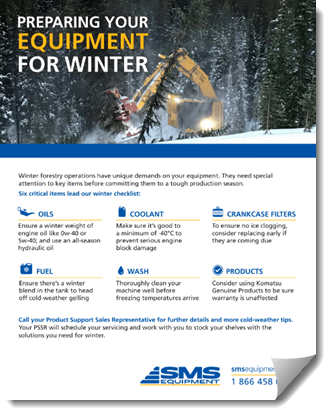Checklist: Winterizing Your Forestry Equipment
In Canada, predicting when winter will arrive is always a guessing game. But you never guess your equipment’s readiness for it.
As a seasoned forestry operator, you know the importance of being prepared. You want maximum field time for your machines. They are a big investment that needs to pay off in your busiest season. Being unprepared for the cold can threaten that margin. So you don’t want to overlook anything that might cause unscheduled machine downtime. “Winter is just around the corner so it’s time to start getting your equipment ready for that busy cold season,” says Dwight Campbell, SMS Equipment Manager, Forestry Products.
Download Our Winterizing Tips Checklist
As a seasoned forestry operator, you know the importance of being prepared. You want maximum field time for your machines. They are a big investment that needs to pay off in your busiest season. Being unprepared for the cold can threaten that margin. So you don’t want to overlook anything that might cause unscheduled machine downtime. “Winter is just around the corner so it’s time to start getting your equipment ready for that busy cold season,” says Dwight Campbell, SMS Equipment Manager, Forestry Products.
Download Our Winterizing Tips Checklist
Six Tips to Take the Bite Out of Winter
1. Oils
Some machines require separate engine oils for summer and winter. Where you’re using a heavy weight summer oil, it should be changed out to a recommended winter weight—an approved 0w-40 or 5W-40. Did you know Komatsu’s HO56 hydraulic oil is recommended year-round?
2. Coolant
Make sure coolant concentration is good for -40 degrees C to avoid costly damage like cracked engine blocks. “You don’t have to change it but always double check what your concentration strength is,” recommends Campbell. “Has someone been topping off with water over the summer while repairing small leaks. This may have diluted the coolant. So it’s best to check.”
3. Crankcase Filters
Tier 4 engines are equipped with crankcase filters that remove engine blow-by gases. Because they also attract moisture, these filters are prone to freezing in winter months. “So changing them now before the manufacturer’s recommended time interval may be advised, to reduce unwanted down time,” says Campbell. “For example, if it has a 2,000-hour life and you’re at 1,500 in September, why not just change it because you know it is full of water and it will create you a problem in November?”4. Winter Fuel
Fuel is blended in winter to remove its paraffin content and prevent it from gelling up. “Winter fuel is introduced at the pumps by blending the summer fuel throughout the fall,” explains Campbell. “At the pump, in August they are selling summer fuel; in January it’s full winter fuel. Between about September and December they start gradually blending it.” So if you run equipment in the summer, shut it down and don’t go back to work until December, that fuel will gel up. “Don’t get stuck with a machine in December that has summer fuel in it,” Campbell warns. “The heavy paraffins in summer fuel will cause issues in the winter.”5. Clean Your Machine
As a busy operator you know equipment suffers oil spills, fuel leaks etc. that can deteriorate hoses and electrical harnesses and cause surprise breakdowns. To head off down times these can cause, Campbell recommends giving your machine a good wash before freezing temperatures arrive. “It is hard to wash a machine in December,” he says. “You can do it with steam trucks but everything freezes up after. So give it one last cleaning before it gets cold.”6. Choose Komatsu Genuine Products
Always consult your machine service and maintenance manual for proper application and change intervals. Adding to that, Campbell recommends using Komatsu Genuine Products. “By choosing Komatsu Genuine lubricants and filters you eliminate the guessing game of ‘have I used the right one?’ he says. “It also removes any possibilities that warranties may be affected if the wrong choice is made.”
Are you ready? Be absolutely sure: contact your local service branch or your Product Support Sales Representative to get the jump on winterization. Your PSSR will schedule your servicing and work with you to stock your shelves with the solutions you need for winter.
Did you know we offer Preventative Maintenance programs?
Contact us for details

